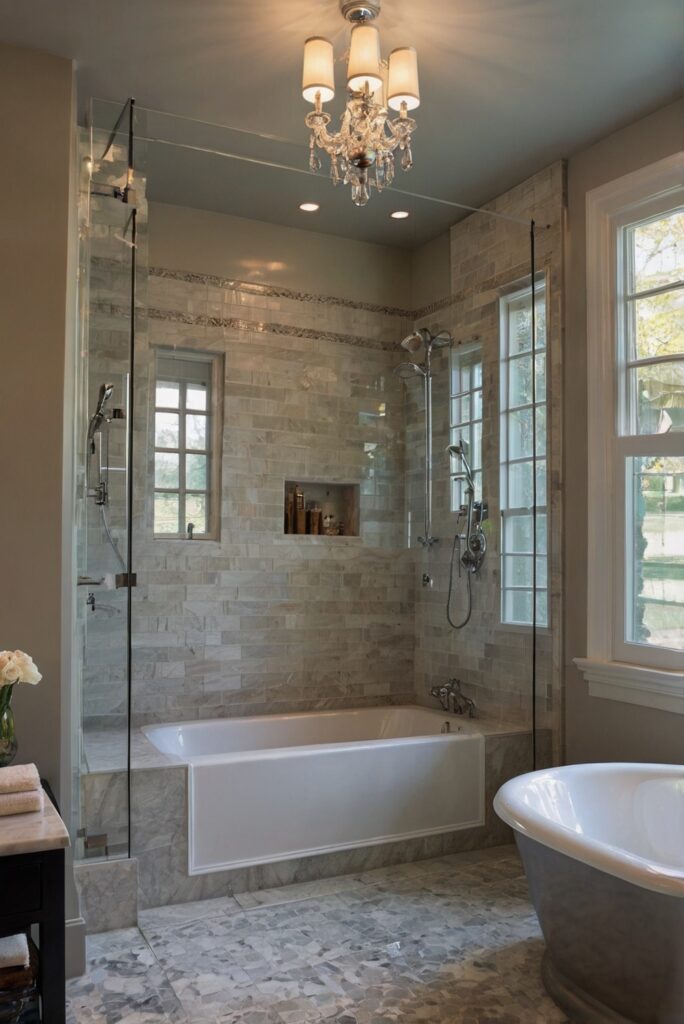Discover how to effortlessly combine a shower and tub in your bathroom to achieve a transitional style. Upgrade your interior design skills with this daily routine for interior designers.
To create a transitional bathroom with a combination shower and tub, start by selecting a color scheme that promotes a relaxed and elegant ambiance. Incorporate elements such as neutral tones, sleek fixtures, and timeless design to achieve a cohesive look. Consider using a glass divider to separate the shower and tub area, maximizing space and light. To enhance the transitional style, mix contemporary and traditional elements like a modern vanity with a vintage mirror. Implement proper space planning by ensuring efficient layout and functionality. Consider seeking advice from home interior designers for a personalized touch. Experiment with different primer paint colors to find the perfect match for your walls, creating a harmonious atmosphere.
Creating a transitional bathroom with a combination shower and tub requires careful consideration of home decorating, interior design, and space planning principles. Be mindful of the color palette, fixtures, and layout to achieve a cohesive and aesthetically pleasing look. Experimenting with various design elements can help you create a unique and personalized space. Don’t hesitate to seek advice from interior designers if needed, as they can provide valuable insights and recommendations. Additionally, pay attention to the functionality and flow of the space to ensure a practical and comfortable environment. By following these steps, you can successfully create a beautiful transitional bathroom that combines style and functionality.
Create a Transitional Bathroom with a Combination Shower and Tub
When designing a transitional bathroom with a combination shower and tub, it’s essential to pay attention to key elements that will help you achieve a seamless blend of modern and traditional styles. Here are some important steps to create the perfect transitional bathroom:
1. Choose the Right Fixtures
Selecting the right fixtures is crucial in creating a transitional bathroom. Opt for fixtures that combine modern and traditional elements. For example, choose a showerhead with a sleek design but in a classic finish like brushed nickel or oil-rubbed bronze. This will help tie together the different styles in your bathroom.
2. Use Neutral Colors
Neutral colors are a key component of transitional design. Consider using shades like beige, gray, or cream for your bathroom walls and tiles. These colors provide a versatile backdrop that allows you to incorporate both modern and traditional elements seamlessly.
3. Mix Materials
Mixing different materials is another important aspect of creating a transitional bathroom. For instance, you can combine sleek glass shower doors with a classic porcelain tub. This blending of materials adds visual interest and helps bridge the gap between modern and traditional styles.
Add Personal Touches
In addition to the above steps, don’t forget to add personal touches to your transitional bathroom. Consider incorporating elements that reflect your style and personality, such as artwork, decorative accents, or plants. These personalized touches will make your bathroom feel inviting and unique.
Consider Lighting
Lighting plays a crucial role in any bathroom design. For a transitional bathroom, opt for a combination of ambient, task, and accent lighting to create a balanced and inviting space. Consider installing sconces around the mirror for task lighting and a chandelier or pendant lights for ambient lighting.
In conclusion, creating a transitional bathroom with a combination shower and tub involves careful consideration of fixtures, colors, materials, personal touches, and lighting. By following these tips, you can design a beautiful and functional bathroom that seamlessly blends modern and traditional elements.
**What is a Transitional Bathroom with a Combination Shower and Tub?**
A transitional bathroom with a combination shower and tub is a design concept that blends traditional and contemporary elements to create a balanced and harmonious space. It typically features a bathtub and a shower in one unit, offering versatility and functionality.
**Why is it Important to Create a Transitional Bathroom with a Combination Shower and Tub?**
Creating a transitional bathroom with a combination shower and tub is important as it maximizes space utilization, caters to different preferences, and enhances the overall aesthetics of the bathroom. It offers convenience for both quick showers and relaxing baths, making it a versatile choice for homeowners.
**What are the Key Elements to Consider When Designing a Transitional Bathroom with a Combination Shower and Tub?**
When designing a transitional bathroom with a combination shower and tub, key elements to consider include the layout, fixtures, lighting, storage options, materials, and color scheme. These elements play a crucial role in achieving a cohesive and functional design that meets the needs and preferences of the users.
**How to Incorporate a Combination Shower and Tub in a Transitional Bathroom Design?**
To incorporate a combination shower and tub in a transitional bathroom design, start by selecting a suitable unit that complements the overall style of the space. Consider the placement of the shower and tub, as well as the surrounding fixtures and accessories. Pay attention to details such as tile selection, hardware finishes, and showerhead options to create a seamless look.
**What are Some Tips for Maintaining a Transitional Bathroom with a Combination Shower and Tub?**
To maintain a transitional bathroom with a combination shower and tub, regularly clean the surfaces, grout, and fixtures to prevent mold and mildew buildup. Use appropriate cleaning products for different materials, such as glass, tile, and metal. Consider implementing a maintenance schedule to keep the bathroom looking fresh and inviting for years to come.

